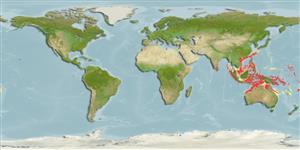Common names from other countries
Klassifizierung / Names
Namen | Synonyme | Catalog of Fishes(Gattung, Arten) | ITIS | CoL | WoRMS | Cloffa
>
Perciformes/Serranoidei (Groupers) >
Epinephelidae (Groupers)
Etymology: Epinephelus: Greek, epinephelos = cloudy (Ref. 45335); kupangensis: Name from Latin suffix '-ensis', denoting place or locality, is appended to the locality of Kupang, Indonesia, the center of the Timor Sea fishery that provided the first author with the holotype and several paratypes..
Environment: milieu / climate zone / depth range / distribution range
Ökologie
seewasser riff-verbunden; tiefenbereich 50 - 300 m (Ref. 111063). Tropical
Indo-West Pacific: Indonesia (Timor Sea), Timor-Leste, Philippines, Taiwan, and Fiji.
Size / Gewicht / Alter
Maturity: Lm ? range ? - ? cm
Max length : 39.1 cm SL Männchen/unbestimmt; (Ref. 111063)
Kurzbeschreibung
Morphologie | Morphometrie
Rückenflossenstacheln (insgesamt): 11; Rückenflossenweichstrahlen (insgesamt): 15-17; Afterflossenstacheln 3; Afterflossenweichstrahlen: 8. This species is distinguished from its Indo-Pacific congeners by having the following characters: lateral line scales 46-49 (vs. at least 51 in all species except E. areolatus, E.
bilobatus, E. bleekeri, E. bontoides, E. chlorostigma, E. faveatus, E. howlandi, E. longispinis, E. macrospilos, E. maculatus, E. merra, E. miliaris, E. polyphekadion, E. quoyanus, E. timorensis, E. trimaculatus), round caudal fin (vs. emarginate to truncate caudal fin in E. areolatus, E. bleekeri, E. chlorostigma, E. geoffroyi, E. timorensis), no distinct spots over most of head and body (vs. numerous distinct spots - not dots - over most of head and body in E. bilobatus, E. bontoides, E. faveatus, E. howlandi, E. longispinis, E. macrospilos, E. maculatus, E. merra, E. miliaris, E. polyphekadion, E. quoyanus, E. trimaculatus) (Ref. 111063).
This fish is part of a large, deep-water drop line fishery, which focuses its efforts on banks and promontories of shelf habitat in depths of up to 350 m (Ref. 111063).
Life cycle and mating behavior
Geschlechtsreife | Fortpflanzung | Ablaichen | Eier | Fecundity | Larven
Tucker, S.J., E.M. Kurniasih and M.T. Craig, 2016. A new species of grouper (Epinephelus; Epinephelidae) from the Indo-Pacific. Copeia 104(3):658-662. (Ref. 111063)
IUCN Rote Liste Status (Ref. 130435)
CITES (Ref. 128078)
Not Evaluated
Bedrohung für Menschen
Harmless
Nutzung durch Menschen
Mehr Information
NamenSynonymeMetabolismusRäuberÖkotoxikologieFortpflanzungGeschlechtsreifeAblaichenFecundityEierEientwicklung
Alter/GrößeWachstumLänge-GewichtLänge-LängeLängenhäufigkeitenMorphometrieMorphologieLarvenLarven Pop.Dyn.RekrutierungDichte
ReferenzenAquakulturAquakultur ProfilZuchtlinienGenetikElectrophoresesVererbbarkeitKrankheitenVerarbeitungMass conversion
PartnerBilderStamps, Coins Misc.LauteCiguateraGeschwindigkeitSchwimmstilKiemenoberflächeOtolithsGehirngrößeSehfähigkeit
Tools
Zusatzinformationen
Download XML
Internet Quellen
Estimates based on models
Phylogenetic diversity index (Ref.
82804): PD
50 = 0.5000 [Uniqueness, from 0.5 = low to 2.0 = high].
Bayesian length-weight: a=0.01175 (0.00571 - 0.02419), b=3.04 (2.88 - 3.20), in cm Total Length, based on LWR estimates for this Genus-body shape (Ref.
93245).
Trophic level (Ref.
69278): 3.8 ±0.5 se; based on size and trophs of closest relatives
Widerstandsfähigkeit (Ref.
120179): mittel, Verdopplung der Population dauert 1,4 - 4,4 Jahre. (Preliminary K or Fecundity.).
Fishing Vulnerability (Ref.
59153): Moderate vulnerability (38 of 100).
